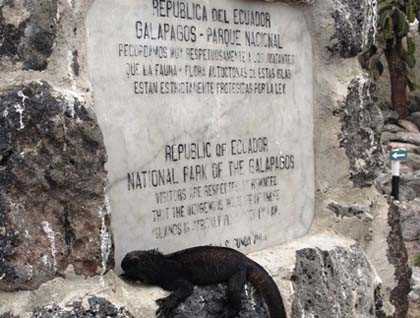We left the inhabited areas of Galápagos and once again found ourselves in a more natural, almost untouched island. Our itinerary, set by the Galápagos National Park Service, brought us to South Plaza, a short navigation from Puerto Ayora.
This is a tiny island, rather flat and uninviting from the distance; however, upon approach, we could see how wrong we were. A dry and hostile environment, it has successfully been colonized by a largish population of land iguanas. We walked through a forest of medium-sized Opuntias or prickly pear trees, quite stunning with their orange-brown trunks and abundant pads and fruit. This tree is vital for the survival of the land iguanas; they provide both the only available fresh water and food, as well as shade against the bright equatorial sun. Many iguanas, either male or female, have territories that include this beautiful species of cactus, and since these trees are concentrated on the western part of the island at times we could see dozens of land iguanas basking in the sun relatively close to one another.
South Plaza is certainly a paradise for reptiles, as it is not only inhabited by land iguanas but by lava lizards and marine iguanas. The southern cliffs of South Plaza offered stunning views of the swells breaking against the shore. Its vertical walls are the home to various species of marine birds; we saw the spectacular acrobatics of many birds maneuvering as they tried to land successfully despite the winds! Here were a number of swallow-tailed gulls, some of which were already nesting; also magnificent frigates, red-billed tropicbirds, and Galápagos shearwaters. The path in South Plazas is a circular one, and we had to cross other interesting corners of this little island, like the “bachelors’ corner,” where the rejected male Galápagos sea lion wait until they regain enough strength to challenge a dominant bull and take over its harem. We also walked through various sea lion territories, with females and young pups playing in the shallow waters. The local landscape is dominated by a salt-tolerant plant, Sesuvium edmonstonei or Galápagos carpetweed, which has tinges of red, orange, and green.
In the afternoon we changed scenery yet once more, as we realize now that the Galápagos Islands differ from one another. We went snorkeling at Santa Fe Island, one of the oldest of the archipelago. A bay with turquoise waters dominates this side of Santa Fe, and it is reputedly a great snorkeling place where one can see many different species of fish, as well as sea turtles, playful sea lions and the occasional ray. Some of our guests took that option and for about an hour they were able to enjoy the underwater world of Santa Fe.
A little later, we were ready to set foot ashore. We landed at a beach with a massive colony of Galápagos sea lions of all sizes; in fact, we were a little worried there wouldn’t be a spot big enough for us to land! The sea lions, as it is usual in Galápagos, were oblivious to our presence so we began our walk without any problem. A very rocky trail leads us inland; our goal was to find the endemic Santa Fe land iguana. This is a different species to other land iguanas previously seen this week, and it is much paler and less numerous. We certainly succeeded in this; despite land iguanas being well camouflaged either in the thick brush or by sitting motionless on a rock. We walked along another magnificent cactus forest, this time with the blue sea and National Geographic Islander in the background. We strolled once again amongst the peaceful sea lions as the sun set spreading its beautiful yellow light over everything…this has been yet another wonderful day in this lost paradise in the Pacific Ocean.







